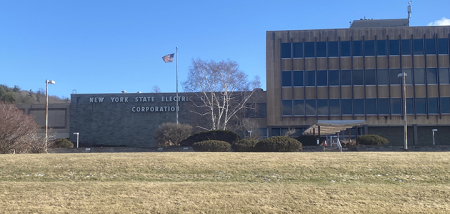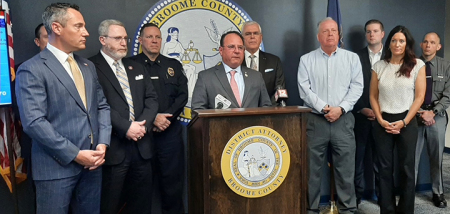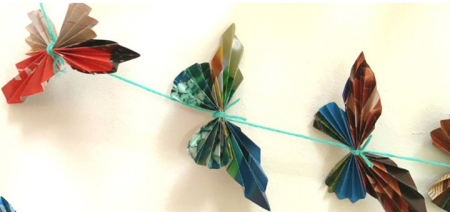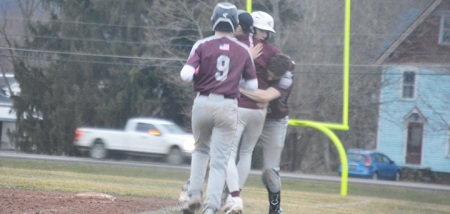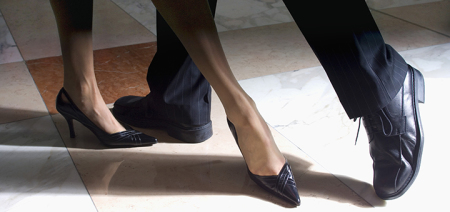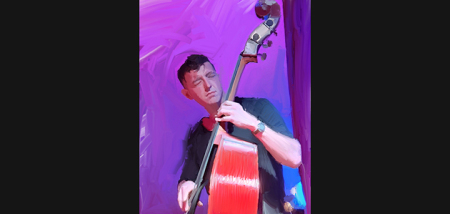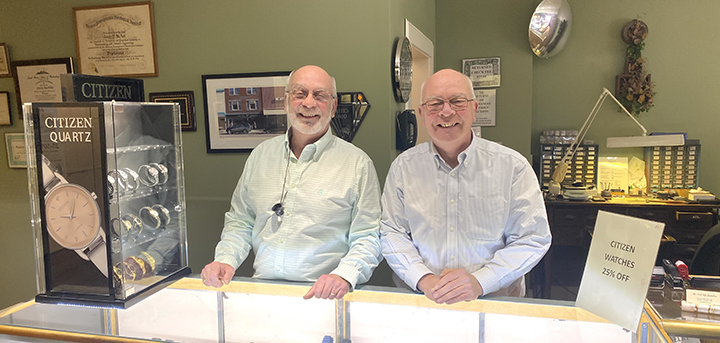When A Homicide Comes To Court
Published:
August 4th, 2017
By:
Tyler Murphy

I hadn't been to the Chenango County criminal court for many years.
On my way to work early that morning I passed the county courthouse just before 6:30 a.m. The City of Norwich was starting to come to life, but it was still mostly quiet. I could see local television anchors and camera crews already broadcasting from West Park.
The antique pillared courthouse has long been a symbol of area's judicial system but criminal cases don't even really take place there anymore, with a few exceptions. That day's murder arraignment was not one them. The proceeding would actually take place a few blocks away.
The Eaton Center is now where most of these fates are decided, but the restructured and refurbished pharmaceutical building provides a less formidable and dramatic back drop for TV viewers.
The case involved the death of an 11-year-old girl in Norwich, and the defendant, James Brower, is charged with rape and murder.
A few hours later at about 8:45 a.m. I arrived at the Eaton Center court. A cluster of cameramen and reporters stood tightly together in a nearby parking lot.
While standing on the public sidewalk, just outside the court, a sheriff's deputy ordered me to join the other media in the adjacent parking lot. I glanced around at all the other members of the public who milled about freely, some of them walked or stood near us as he gestured me away. I told him I was going to stay on the sidewalk. He didn't seem to like the response, and then told me not to get in the way of any vehicles.
After a time, a Chenango County Corrections van appeared and quickly turned into a rear parking area that police had cleared. The media who had been designated to the parking lot readied their cameras to take pictures and video of the accused as he went from the van and into the courthouse.
Before the defendant was escorted from the van, the sheriff's deputy who had been watching the reporters ran over to a large maroon pick-up truck and got behind the wheel. The officer quickly followed the van to the rear of the building and parked the large truck directly in front of the designated media spot and between their view of the entrance.
A moment later two large correction officers flung the jail van's doors open and in less than a few seconds, rushed the defendant inside.
This displeased some, and grumblings could be overheard as the pack of at least 15 people, consisting of 8 different news organizations, herded their way toward the court entrance of the Eaton Center.
Capturing a perp walk is always something of an ugly affair for news gatherers but this incident seemed more homely than usual. I will say this for the correction officers and court security that day, and most other days: they run a tight ship.
As I waited my turn to pass through a metal detector with my paper pad and pen, camera crews in-front of me began unpacking their equipment for security searches and x-ray scans.
The demeanor of the officers at the front security desk was much different from the experience outside the building. The officers were kind, informative, and a few even made refrained jokes, as the mass of news and security ebbed into a nearby waiting area.
All camera and recording equipment is banned from New York State courts without permission from the judge.
Security helped crews carry their equipment to an empty room where it would be kept by them until you left the building or the judge signed an order to bring it into the courtroom.
The better informed filled out a court request to record the proceedings. Once complete the court reviews it, and typically as a representative of a media organization, you’re called to appear in front of the judge and explain its intention. The court then gets feedback from the defense and prosecutor before making a decision.
On this day however, the court was prepared for the heightened interest in the case, and handed them out to the press.
Eventually we were escorted to the small courtroom, nearly filling its maximum seating occupancy more than halfway with reporters.
The defendant was brought in and court began with the judge reviewing press applications. The public defender wanted all news organizations banned completely from court, let alone allowing them to take pictures. The prosecution had no objection. No surprises there.
The judge told us we had to choose one person from all the competing organizations to be the designated video recorder and another to be the photographer.
The reporters bustled with a hushed commotion as the court waited for us to figure it out. Some avoided the prospect, like a child who wanted to lose at a game of musical chairs. Others seem slightly pricked by the idea of relying on a direct competitor. After about a minute of “do you care,” “we can do it,” and “sure,” the group selected a pool cameraman.
The judge then asked who would do the photography. There was a short, but long seeming silence, as people’s eyes found the few newspaper writers in the room.
The Evening Sun was designated as the court’s official pool photographer for the case. I’m required to share all the pictures with everyone, but I’m the only one who gets to bring a camera into the court and take them. A curse and a blessing that I’ve accepted a few times before.
With a 5-minute recess, I ran to my car, got my camera, and returned to the courtroom. It was so full of people that many had to stand along the wall. It made wonder how empty the old, West Park courthouse building was at that moment. It has enough room to fit a whole congregation.
I got a premium location as a pool photographer, another nice perk to the responsibility. Being both a writer and a photographer for the proceeding took some good timing.
I was so caught up with everything I needed to do and catch up on, that I nearly forgot how emotionally intense this proceeding was going to be. Being a crime reporter is compelling and difficult. I’ve covered several murder cases in Chenango County beginning to end. I’ve also covered a few homicides in the Albany area.
In my experience, there is hardly a way to describe the intensity of court. In many ways, the things said there can be hard to relate. I find myself being forced to re-calibrate how some things are presented, because they are often too brutally or gruesomely depicted, or involved raw reports about victims. The experiences are not sensitive to readers' expectations.
When writing I often imagine how a story may read to a defendant, a victim, the attorneys involved and to someone who’s never heard of the case before. Sometimes my own judgment can be paralyzed by the several different points of view I’m considering.
There is no easy way to say some things though, no matter the juxtaposition. It’s best to just state it plainly. The defendant is accused of smothering a little girl to death, a relative, while he was raping her.
Sometimes I almost feel like the words seem so obscene they shouldn’t be on the page, but being a good reporter isn’t about that. It’s about telling people what really happened in the clearest way I’m able.
The defendant only spoke once to say he was satisfied with the public defender’s representation. He avoided almost all eye contact with everyone in the court, except for the lawyers and judge. He made little, if any, physical expressions while he listened to the facts of the case and the charges against him.
The preparations to hold the proceeding and the waiting, took much longer than the actual arraignment, which lasted maybe 25 minutes. Afterward the district attorney held a press conference and was pebbled with a few dozen questions, the most common answer being, “I can’t answer that.”
Family members involved in the case watched from a distant corner of the spectacle, and when one reporter tried to go talk to them (not me) the entire group noticed and uncontrollably lurched in their direction to do the same. I felt appalled, but compelled to at least listen for any responses. Luckily the family’s minister saw it coming and moved to intercept the press as the family retreated. He was kind but stern, “no statement from the family,” he said.
As I left the Eaton Center, the anchors and cameramen began setting up their shots and broadcasts, just as they had been doing earlier that morning.
Author: Tyler Murphy - More From This Author
Comments
